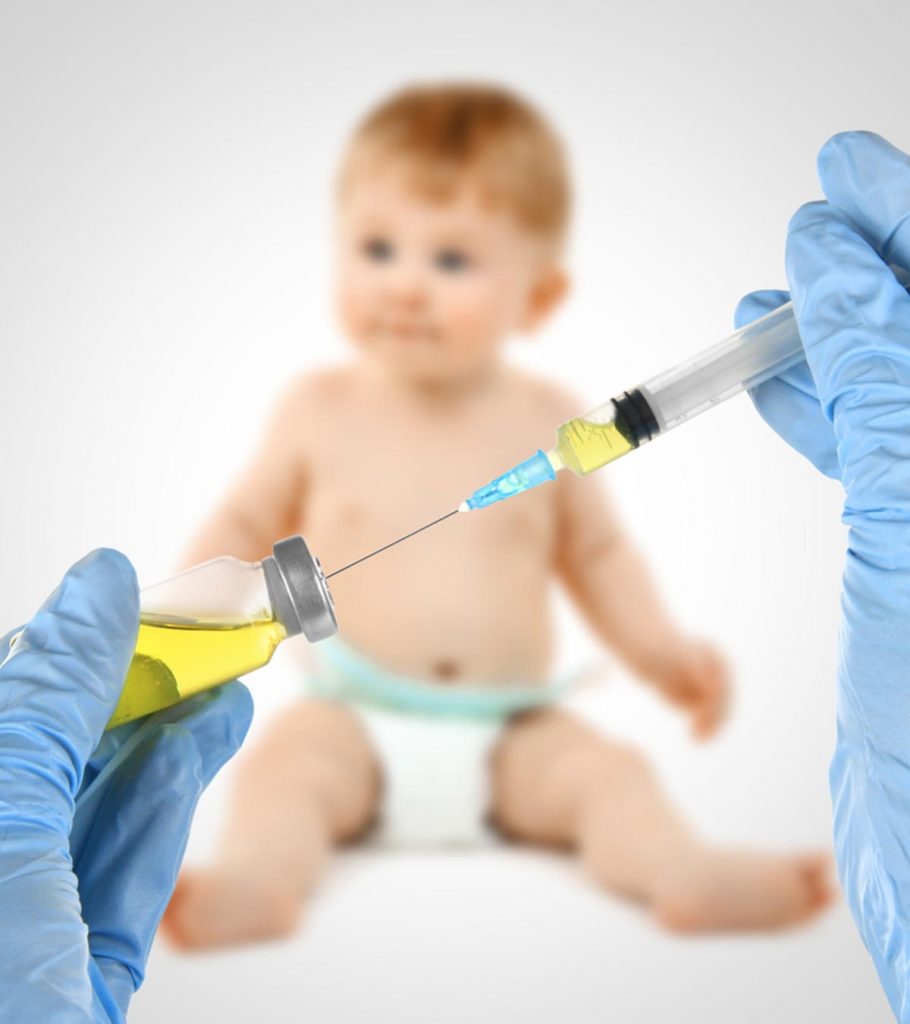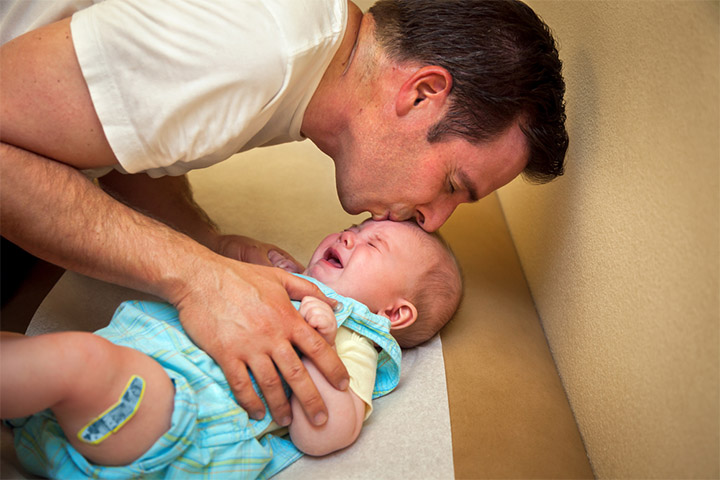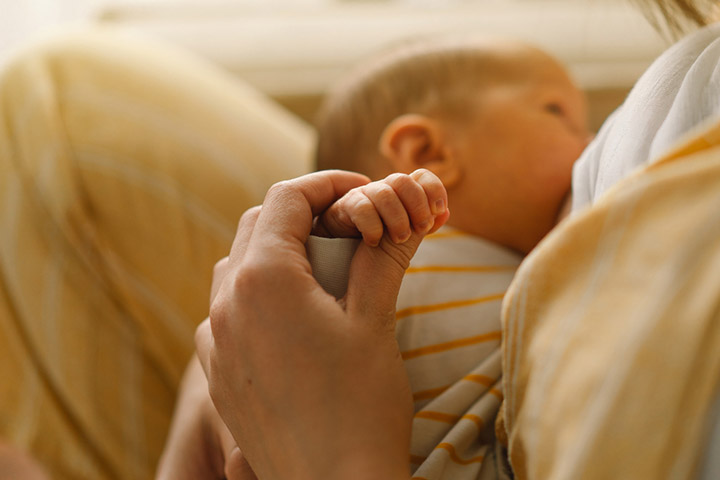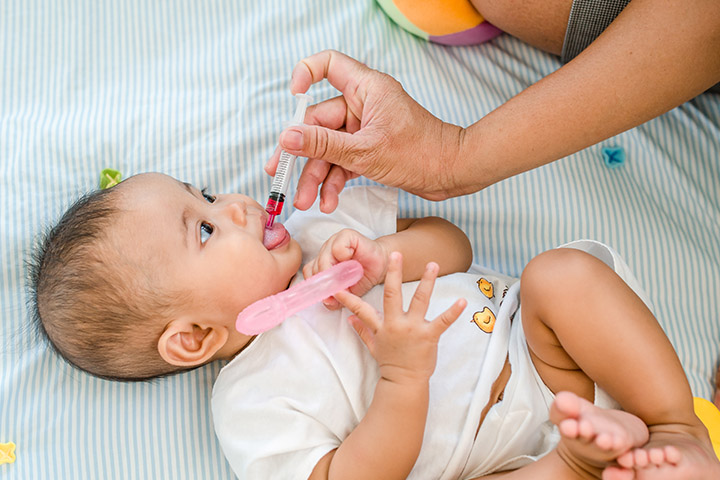The US Centers for Disease Control and Prevention (CDC) states that immunization is extremely important for babies and can protect them from more than 14 serious childhood illnesses (1). According to the American Academy of Pediatrics, most childhood vaccines exhibit a 90% to 99% efficacy in preventing these diseases. Certain vaccines help develop herd immunity against contagious diseases caused by deadly viruses(like measles, rubella, and rotavirus) and improve public health. Managing the pain after vaccination in babies is crucial, and as a new parent, the first thing you’d probably want to do is find ways to reduce the pain.
The benefit of vaccines is that they outweigh the minor discomfort caused by the pain after inoculation. In this article, we discuss the possible after-effects of vaccination on your baby and tell you how you can help reduce pain.
Tips To Manage The Pain After Vaccination For Babies
Pain is a common after-effect of vaccination. Minimizing pain can help make vaccination less intimidating and stressful both for the newborns or infants and the parents. Babies exhibit lesser fear of needles and fewer healthcare avoidance behaviors on growing up when the pain from vaccination was managed better (2).
The following are some suggested tips to manage the pain after vaccination in infants.
1. Give some quiet time
The baby might be irritated and exhausted due to crying after the vaccine. Put the baby in a comfortable, temperature-controlled, and quiet room. Dress them in loose, comfortable, breathable clothes.
2. Hold the baby
Hold the baby close to yourself during and after vaccination. The baby might get the feeling of safety and will be less distressed by your skin contact. The CDC recommends holding and comforting the baby during vaccination to prevent the baby from moving his/her limbs (3).
3. Touch and soothe the baby
A study on determining the effective physical interventions to reduce pain after vaccination proved the “5 S” to be relaxing to the baby (4). The “5 S” are swaddling, side/stomach position, shushing, swinging, and sucking.
4. Distract the baby
Distraction is defined as the use of strategies to take an individual’s attention away from the procedure (2). A new toy, book, bubbles, or a simple game of peek-a-boo might help in distracting the baby, and making vaccination less stressful.
5. Breastfeed
Breastfeeding is believed to have an analgesic effect on babies due to several reasons like skin-to-skin contact, the soothing effect of sucking, being held by the mother, and the sweet taste of breastmilk. The mother may start breastfeeding the baby before the injection is administered and continue doing it during the vaccination procedure as well. However, if the mother and the baby are not comfortable with this arrangement, then feeding pumped milk through a bottle or formula feeding might also work (2).
6. Give sweet-tasting solutions
Administering sweet-tasting solutions might help in distracting and calming the baby. Studies have shown that giving a few drops of a sweet solution before the procedure, or giving a pacifier dipped in a sweet solution during the procedure, might ease the baby. However, this method is only recommended when the baby cannot be breastfed or formula-fed for some reason (2). Consult the doctor before choosing a sweet solution, like sugar syrup, for your baby. Never give honey to babies below the age of 12 months since it has the potential to cause gastrointestinal infection.
7. Apply cool pack
Applying cool packs of ice might help alleviate pain after vaccines. The application of a cool pack makes the skin numb, and thus reduces pain at the site of injection. Remember, not all infants might be able to tolerate the coolness of ice and might cry when touched with an ice pack. Discuss it with your pediatrician before using any cool packs for your baby (2).
8. Give more liquids
If you are exclusively breastfeeding the baby, then continue doing the same after vaccination too. But if you have already started giving solids to the baby, then they might consume only liquid and eat lesser than usual for the first 24 hours (3). In such a case, you can consider feeding a liquid diet of purees, soups, and mashed food. Feed the baby whatever he/she is comfortable in consuming for a day after vaccination.
9. Use topical anesthetics
Applying topical anesthetic agents might help in relieving pain from the vaccination. Topical anesthetics are available as rub-on gels as well as sprays. The gels might take an hour to show their effectiveness. Discuss with the pediatrician before using any over-the-counter (OTC) anesthetic agents (2).
10. Administer oral analgesics
The doctors might prescribe medicines like acetaminophen or ibuprofen to manage pain after vaccination. However, these medicines are given after considering the baby’s weight, age, and general health. Do not give any over-the-counter (OTC) medicines to the baby without consulting the doctor (5).
Other Possible After-Effects Of Vaccination
The pediatrician usually informs what reactions to expect after administering a vaccine or a booster to the infant. The following are the common side effects of vaccinations (6).
- Localized reactions like redness, swelling, and pain at the site of injection.
- Fever due to vaccines starts within 24 hours of vaccine administration and may last for one or two days.
- Delayed reactions of fever and rash after chickenpox and MMR shots. These reactions appear anytime between one to four weeks after taking the doses.
- Very rarely, severe anaphylactic reactionsiXotentially life-threatening allergic reaction with symptoms such as difficulty breathing, hives, and facial/throat/tongue swelling to vaccines occur. They may start after two hours of vaccine administration. They need immediate medical attention.
If you suspect anything unusual in your baby’s health after vaccination, then contact the doctor immediately.
These are a few tips you could take to reduce the discomfort caused by vaccination in babies. After the vaccination, dress your baby in comfortable clothing that wouldn’t rub on the injection site frequently. Caress your baby when in pain and try soothing techniques. Although the period immediately after vaccination might be stressful for you, understand that this is only temporary. As the days progress, the pain of vaccination would fade away, and your baby would start to feel relaxed. Also, keep a close eye on the baby after the injection and consult a doctor promptly if they show any concerning signs or adverse reactions.
Key Pointers
- Preparing the skin before the shot can help minimize discomfort by numbing and making the area less sensitive.
- Distracting the baby with toys, singing, or a pacifier during the shot can help to take their attention off the discomfort.
- Breastfeeding or providing the baby with a bottle before or after the shot can help calm the baby and relieve pain.
- Gently massaging or hugging the baby close might bring comfort and relieve pain.
- Acetaminophen or ibuprofen can assist in reducing swelling and discomfort post-vaccination.
Your child must be vaccinated at the right time. Children may sometimes have reactions to vaccines which is a normal occurrence. Watch this video to learn about what to expect when your child is vaccinated and how vaccines work to protect them from disease.














